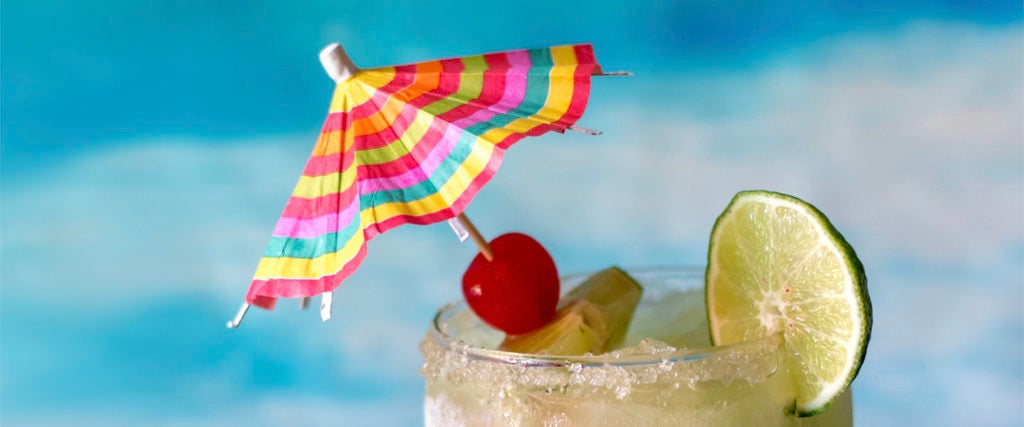For a while, the classiest thing in the world was for a drink to have a small paper umbrella in it. It might be impaled through a chunk of pineapple or wedged in with a big-ass chunk of ice, but the important thing was that it was there — a tiny little colorful parasol, sheltering your drink from shit-all.
It was born out of tiki drink culture, a cherry-picked mishmash of Caribbean and Polynesian elements bundled together and packaged for American consumers in what Eater calls “an act of cultural pillage.” Elements of ancient, rich cultures were essentially stripped of their meaning and incorporated into bars solely for their visual appeal — NPR compares a tiki mug in the shape of a Polynesian deity to visiting a “Christian bar” and drinking out of a glass shaped like the Virgin Mary.
The first tiki bar, Don the Beachcomber, opened in L.A. in 1934, offering up a variety of tropical flavors. But it wasn’t until after World War II, when hundreds of thousands of soldiers returned from the South Pacific, that the concept really took off. The escape and exoticism conveyed by bright colors, palm trees and strong, fruity, rum-based cocktails was incredibly desirable, and the amount of tiki bars in the U.S. exploded. This coincided with the rise of the suburbs and backyards, and countless homes suddenly had their own tiki bars complete with their own problematic mugs.
“There’s some PR issues with tiki,” says Elliot Ball of London’s Cocktail Trading Company. “There’s something obviously culturally insensitive about a mug depicting a Polynesian god being used to drink alcohol from.” As such, Ball’s own bars steer clear of anything incorporating religious, spiritual or cultural iconography in favor of non-problematically thematic alternatives — mermaids, bananas, etc. “Rum is awesome. Fresh juice is awesome. And the general energy of tiki drinks — big, bright, colorful — is really positive. If you can stick the whole thing in a coconut, all the better,” he adds.
For all that clumsy appropriation, though, there isn’t a tradition of tiny paper umbrellas in the South Pacific (China, however, is a different story, as paper parasols have been around there for 2,000 years). They supposedly originated in 1959 with Hilton Waikiki bartender Harry Yee, who was using sticks of sugarcane to garnish his cocktails. Drinkers would chew them and leave them in ashtrays, leaving Yee and his staff with a disgusting, syrupy mess to clean up, so he switched to the umbrellas.
What isn’t clear is why Yee had tiny wooden parasols in the first place. Regardless, the idea took off, and the same anything-goes attitude that saw tiki bars serve Chinese food applied here, too. “A lot of visually-driven cocktails are all about big colors and flavors, big fruits and bright imagery, and cocktail umbrellas fit in well with that,” Ball explains. “It’s not like you get cocktail umbrellas in a pleasing pastel green. They’re all fucking crazy, bright colors.”
A cocktail umbrella is immediate shorthand for opulence and escape. What is luxury if not a beautiful, umbrella-topped cocktail in your hand? Along those lines, reviews of cheap mass-purchased ones feature comments like, “Makes you feel like you’re on vacation in the backyard.”
While a cocktail umbrella doesn’t have the same cultural iffiness of some other elements of tiki bars, it does bring its own problems — namely uselessness. A real umbrella protects you from the rain, and a parasol from the sun, but a cocktail umbrella doesn’t protect shit from shit. Nor does it keep drinks cool, stop ice from melting or do anything at all. To say nothing of what all those purposeless cocktail umbrellas mean for the environment.
“Cocktail umbrellas are obviously, absolutely obsolete for anything other than a visual purpose,” says Ball. “You don’t need a cocktail umbrella to have the drink. But then you get into the whole question of where necessity lies anyway: Is the drink itself necessary? We’re not drinking these things because we’re about to die of thirst, we’re doing so for enjoyment. So yeah, in many ways they’re ridiculously archaic. And there’s a fairly high production cost, both in physically making them and in how mixing different materials means they’re unlikely to be recycled and are destined for the trash.”
There are marginally more eco-friendly all-bamboo alternatives, but they don’t have the same charm. And so, given that they’re basically both meaningless and useless, do we really still need cocktail umbrellas?
“I love the cocktail umbrella personally, but it’s certainly a double-edged sword,” says Martin Cate, author of the James Beard Award-winning Smuggler’s Cove: Exotic Cocktails, Rum, and the Cult of Tiki. “I’m trying to promote vintage recipes made with fresh ingredients and good spirits, while the umbrella is closely associated with the kind of syrupy artificial drinks that the exotic cocktail devolved into in the 1970s and 1980s.”
However, as Ball points out, being a remnant of the past isn’t necessarily undesirable. “It’s quite an outdated style of drinks-making, but as we all know, that generational divide can go ‘round in circles. What your parents did is the least fashionable thing imaginable, but what your grandparents did is kind of cool.”
Or as Cate puts it bluntly, “Cocktail umbrellas may not protect you from the elements, but they don’t change the taste of your drink, either. And at the end of the day, guess what? People love ‘em.”

